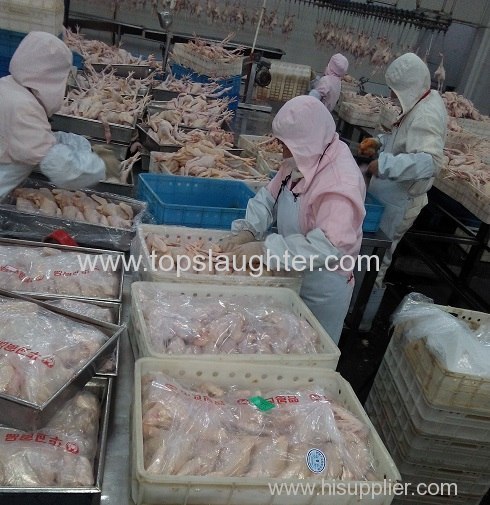
|
TOPLEA MACHINERY IMP &.EXP CO.,LTD
|
Gold Index: 15103
Product (155)
- Slaughterhouse Equipment (84)
- Poultry Farming Equipment (7)
- Cold Room (19)
- Rendering Equipment (22)
- Food Processing Equipment (23)
Poultry News (81)
Industry News (34)
Lay Out Reference (1)
INTRODUCTION TO THE POULTRY PROCESSING INDUSTRY (11)
Blog (23)
Cooperation company (9)
News (10)
Credit Report
Products Index
Blog
Basic steps of Poultry processing

Every large scale poultry processing plants are common around the world. They are specially designed to process poultry, and include main steps, such as poultry slaughtering, feathering, evisceration, chilling and packaging. The process can be made fully automated or semi-automated, depending on each poultry processing plants' requirements.
The first step is receiving and unloading the birds from poultry cages. Birds are unloaded from crates and placed on the shackle line first, that is usually done manually. During the unloading process, a special care of birds should be taken to avoid or minimize bruising of the birds that can excite them, and later on affect quality of meet.
The first step is receiving and unloading the birds from poultry cages. Birds are unloaded from crates and placed on the shackle line first, that is usually done manually. During the unloading process, a special care of birds should be taken to avoid or minimize bruising of the birds that can excite them, and later on affect quality of meet.
After hanging birds onto the shackle conveyor, they are led to the stunner. Stunning is common in most of the poultry processing plants, expect when there are some religious considerations that must be strictly followed, for example Islamic and Jewish laws known as Halal and Kosher. Stunning can be done in different ways too, but to date electric water bath stunner is still the most common used in poultry processing plants. Stunning is used to minimize pain and sufferings of animals during the slaughter process. After animal being stunned, it feels no pain and remains unconscious till death.
When bird is stunned, it goes through the bleeding process. When the blood vessels in the neck are cut, it results in bleed-out. Bleeding time could vary depending on type and size of the bird. It could be around two till five minutes.
After bleeding line there is a scalding process, when the birds are immersed in hot water to loosen their feathers, preparing for the next process that is de-feathering. Feather removal is done by mechanical pluckers with rubber fingers rubbing feathers off of the carcass. Scalding process done before is very important to reduce feather attachment effectively and improve quality of product.
Oil gland and feet removal can be done by automated equipment or manually. During the automated process the oil gland is cut off by a rotating blade. Also feet are removed by rotating blade.
In the evisceration process the body cavity is opened and viscera from it withdrawn. Many processing plants still do it manually by knife and scissors. But it can be done also semi-automatically or fully automatically. After that inspection should be done to make sure that there are no problems or diseases, and only birds free of diseases will go to the marketplace.
Before chilling process birds should be washed to completely remove any debris left on the carcass after de-feathering and evisceration processes. Then chilling process must take its turn as soon as possible to minimize possibility of microbial growth. Now the most common used chiller is counterflow chiller where the chicken carcass moves counter to the flow of clean cold water.After chilling, poultry is usually weighted and packed or it can be deboned for further processing.
Pre Page:
How To Choose The Site Of Slaughterhouse
Next Page:
Poultry water bath stunner




